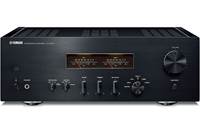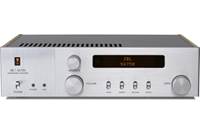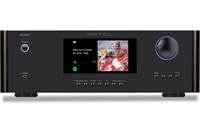About the NAD Masters Series M3

How do you do most of your music listening?
How do you do most of your music listening?
Nothing against smartphones, computers, or home-theater-in-a-box systems, but if that's how you squeeze music into your life, then you're missing one of life's sublime pleasures. Such multi-purpose gadgets, when used for music, serve up the sonic equivalent of fast food. If music means more to you than that, consider building a music-first system with the NAD M3 Masters Series integrated amplifier as your foundation.
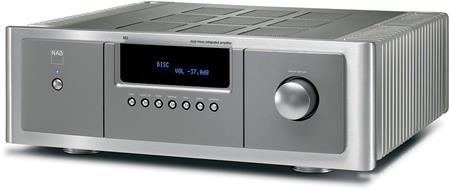
Built solid
The M3's rugged chassis is built with 2-millimeter-thick steel plates and a front panel of aluminum and die-cast zinc. All of the heavy-duty gold-plated signal connectors are specifically engineered for the NAD Masters Series components.
The guts of the M3 are as impressive as its armor. For precise adjustments, the volume, balance and tone controls use 1 percent resistors controlled by digital switches. Input selectors use the same sealed reed relays found in some of the world's most expensive hi-fi components. Because the signal never has to travel to the front panel for switching or adjustment, noise and distortion are minimized.
A powerful value
NAD's PowerDrive™ technology ensures that the M3 delivers maximum undistorted dynamic power into the connected speakers under all conditions. Like a turbo-charger, the PowerDrive signal processor senses the demands placed on the amp and delivers higher current only when it's needed. PowerDrive allows the M3 to sound even more potent than you would expect from its "Full Disclosure" rating of 180 watts x 2 channels.
Pair the M3 with a matching NAD M5 CD player and PSB Synchrony One floorstanding speakers. You'll enjoy a level of performance that audiophiles often pay far more to attain.
Plenty of system-building options

You can assign your own names to the six pairs of RCA and one set of balanced XLR inputs. One of the two preamp outputs features a selectable biamp mode with built-in 40, 60, 80, and 100Hz low-pass filtering for a subwoofer.
Wondering what you'll do with all those inputs? Think outside your main listening room. Connect a second amp to the M3's Zone 2 pre-outs, and you'll be able to take advantage of its independent Zone 2 source selection (and the handy Zone 2 remote control). You could have the loudest, best-sounding outdoor speakers in the neighborhood.
Product highlights:
- 180 watts x 2 channels into 8 ohms (20-20,000 Hz) at 0.004% THD
- 180 watts x 2 channels into 4 ohms (20-20,000 Hz) at 0.004% THD
- dual mono design with separate unregulated, and discrete regulated power supplies for different stages
- 4-ohm capability allows use with a wide range of speakers
- signal-to-noise ratio: 130 dB
- PowerDrive™ circuit with automatic speaker impedance sensing delivers maximum dynamic power output regardless of speaker load
- distortion-canceling circuit for high-accuracy sound
- twin custom-made "Holmgren" toroidal transformers
- all-discrete circuitry with four pairs of high-wattage output transistors per channel
- 6 RCA audio inputs and 1 rec out
- one balanced XLR input
- main-amp input and 2 preamp outputs for connecting a powered subwoofer or separate amplifier for bi-amping
- Zone 2 output with independent source selection
- switching for two pairs of speakers
- two pairs of custom gold-plated speaker binding posts
- biamp mode with selectable 40, 60, 80, 100 Hz crossover frequency on preamp output 1
- 12-volt trigger output
- 1 IR input/2 IR outputs for sophisticated remote control solutions
- RS-232 interface for advanced custom installations
- detachable AC power cord
- separate remote controls for zones 1 and 2
- weight: 68 lbs.
- 17-3/16"W x 5-7/8"H x 18-1/16"D
- warranty: 3 years
- MFR # M3
What's in the box:
NAD Masters Series M3 owner's manual
- Integrated amplifier
- 68" Power cord
- Wireless remote control (M3)
- 2 "AA" batteries
- 2nd Zone remote control (ZR3)
- CR2025 Lithium battery
- 2 Pre-out/Main-in jumpers (installed)
- Owner's manual (English/ French/ German/ Dutch)
- Owner's manual (Spanish/ Italian/ Portuguese/ Swedish)
- Warranty information
Customer reviews for NAD Masters Series M3
Loading...
Loading reviews...
Average review:
5.0 out of 5 starsThanks for submitting your review
Customer photos
This review was collected as part of a promotion
Pros:
Cons:
More details on the NAD Masters Series M3

Features & specs
| Performance Specs | ||
|---|---|---|
| Watts RMS per Channel (8-ohms) | 180 | |
| Watts RMS per Channel (6-ohms) | Not given | |
| Watts RMS per Channel (4-ohms) | 180 | |
| Frequency Bandwidth | 20-20k | |
| THD | 0.004% | |
| Minimum Impedance | 4 ohms | |
| Amplifier Class | --- | |
| Signal to Noise Ratio | 130 | |
| DAC Bit Depth | --- | |
| DAC Sample Rate | --- | |
| Features | ||
| Built-in DAC (Digital to Analog Converter) | No | |
| Wi-Fi | ||
| Built-in Radio Tuner | None | |
| Room Correction | --- | |
| High-res Audio Playback | ||
| From Network | No | |
| From USB Thumb Drive (USB-A) | No | |
| From Computer (USB-B) | No | |
| Bluetooth | ||
| Version Info | --- | |
| Receiver Mode | No | |
| Transmitter Mode | No | |
| AAC Playback | No | |
| aptX Playback | No | |
| aptX-HD Playback | No | |
| LDAC Playback | No | |
| Connections | ||
| RCA Line-level Inputs | --- | |
| XLR Line-level Inputs | --- | |
| Phono Input | No | |
| Optical Digital Inputs | --- | |
| Coaxial Digital Inputs | --- | |
| USB Input | --- | |
| HDMI Inputs | --- | |
| Stereo Preamp Outputs | --- | |
| Subwoofer Outputs | Yes | |
| Recording Output | Yes | |
| HDMI Output | --- | |
| Home Theater Bypass | No | |
| Pre-out/Main-in Loop | No | |
| Headphone Output | No | |
| Removable Power Cord | --- | |
| Streaming Compatibility | ||
| Apple AirPlay | No | |
| Apple AirPlay 2 | No | |
| DTS Play-Fi | No | |
| Chromecast built-in | No | |
| Roon | No | |
| HEOS | No | |
| BluOS | No | |
| Dimensions and Warranty | ||
| Width (inches) | 17-3/16 | |
| Height (inches) | 5-13/16 | |
| Depth (inches) | 18-1/16 | |
| Weight (pounds) | 51.8 | |
| Parts Warranty | 3 Years | |
| Labor Warranty | 3 Years | |
Product Research
Features
Controls
Connections
Specifications
Features
Overview: The M3 features a Dual Mono design with separate unregulated and discrete regulated supplies for different stages of the 2 channels. The custom wound Toroidal transformers use proprietary magnetic shielding technology. The lack of audible noise and distortion is the result of analog circuits combined with digital controls. Freed of the constraints of traditional analog switches, NAD devised an architecture using precision 1% resistors controlled by digital switches for all the level adjustments required for volume, balance, and tone control. Input selection is done via precision sealed reed relays. An advantage of this architecture, in addition to its precise performance, is the ability to place controls in the most advantageous physical position within the circuit. The signal never has to travel to the front panel for switching, as with traditional amplifier designs. Keeping signal paths as short as possible is also aided by the use of SMD (miniature surface mount) components and multi-layer PCBs (circuit boards). Special attention was paid to the control of mechanical resonance throughout the chassis, as this can affect sonic performance. The special isolation feet use aluminum and silicon rubber in a vibration damping configuration.
PowerDrive: NAD's PowerDrive technology measures load impedance continuously on both channels and adjusts the power supply voltage for maximum undistorted dynamic power to the connected speaker at all times and under all operating conditions. The signal processor also continuously measures temperature and average long term power and, based on this information, chooses the optimum voltage.
Pre-out/Main-in Loop: Factory jumpers connect the main amplifier input to the Pre Out 1 preamp outputs. This offers the flexibility of inserting an equalizer, surround processor (when using multiple amps), or another type of processor between the two stages.
Dual Preamp Outputs: The second set of preamp is convenient for bi-amping speakers or adding a powered subwoofer.
Crossover: A high-pass crossover can be engaged for the preamp 2 outputs, useful when bi-amping the speakers or using a powered subwoofer. The crossover options are 40 Hz, 60 Hz, 80 Hz, 100 Hz, and Full Range. The slope is 12 dB/octave.
Input Level: The volume level can be trimmed individually for each source, so there's no volume change when changing inputs; the range is +/- 9.5 dB.
Input Names: The name displayed for each input can be reassigned, up to 20 characters.
Tone: Bass and treble are adjustable +/-5 dB. The Spectral Tilt function simultaneously raises the bass and reduces the treble, or vice versa; +/-3 dB.
Remote Controls: The M3 wireless remote will control the amp and the matching NAD DVD/SACD player. A second wireless remote, the ZR 3, is included for controlling the Zone 2 output.
Controls
Front Panel:
- Power: toggle between power on and standby
- Listen: choose input for listening; Disc, CD, Tuner, input 4, input 5, input 6, or Balanced input
- Record/Zone 2: choose input for recording or listening in Zone 2; Disc, CD, Tuner, input 4, input 5, input 6, Balanced input, Local (same source as main listening zone), or Off
- Mode: toggle between listening modes; Stereo, Mono, Left, Right
- Balance: adjust left/right balance and trim the input level for each source
- Tone: adjust Bass, Treble, and Spectral Tilt
- Bi-Amp: choose the high-pass crossover point for the internal amp
- Speakers: choose which speaker outputs are active; A, B, A+B, or Off
- Volume: rotary volume control
Rear Panel:
- Power: master power switch
Connections
Rear Panel:
- Speakers: the speaker binding posts will accept single banana plugs, pin connectors, spade lugs up to 0.59" wide, and bare wire up to 10 gauge; there are four speaker outputs, A (left and right) and B (left and right)
- Inputs: stereo RCA input jacks for Disc, CD, Tuner, Input 4, Input 5, and Input 6
- Balanced Input: stereo XLR input
- Main In: stereo RCA preamp inputs; jumpers to the Pre Out 1 outputs are factory installed
- Pre Out 1: stereo RCA preamp outputs; jumpers to the main amplifier inputs are factory installed
- Pre Out 2: stereo RCA outputs for feeding a powered subwoofer or another amplifier; the volume level is the same as Pro Out 1
- Record Output/Zone 2: stereo RCA output jacks for recording or listening in Zone 2
- IR In: 3.5mm mini-jack input, used to control this unit using an optional infrared repeater or the IR output of another component
- IR Out: two 3.5mm mini-jack outputs, used to control other NAD components
- 12 Volt Trigger Out: turn on/off another device along with the M3; the +12 volt trigger output is a 3.5mm mini-jack; the maximum output is 50 mA
- RS 232: the RS-232 port allows connection to a compatible PC or external whole-house control system from companies such as AMX or Crestron
- AC Input: 2-pole IEC power input for use with included cord (or optional upgraded cord)
Specifications
Amplifier Section:
- Continuous Power: 180 watts x 2 into an 8Ω or 4Ω load, 20 Hz - 20 kHz, no more than 0.004% THD, both channels driven simultaneously
- Dynamic Power:
- 8Ω: 280 watts x 2
- 4Ω: 480 watts x 2
- 2Ω: 785 watts x 2
- Dynamic Headroom: 4.2 dB at 8Ω
- Rated THD (Total Harmonic Distortion): 0.004% (20 Hz - 20 kHz)
- Signal/Noise:
- >107 dB (ref 1 watt)
- >130 dB (ref 180 watt)
- Damping factor: >150 (ref 8Ω, 50 Hz)
- Frequency response:
- +/- 0.03 dB: 20 Hz-20 kHz
- - 3 dB: 20 Hz-80 kHz
- Input impedance: 20 kΩ + 680 pF
- Input sensitivity: 1.38 volts (ref rated power into 8Ω)
- Voltage gain: 29 dB
- Power Requirement: AC 120V 60Hz
- Weight: 51.8 lbs (23.5 kg)
Preamp Section:
- Input impedance: 150 kΩ + 500 pF
- Balanced input impedance: 120 kΩ + 100 pF
- Input sensitivity: 446 mV (at rated power)
- Frequency response: 5 Hz-70 kHz (+/- 0.3 dB)
- Output impedance:
- Pre-out 1/Pre-out 2: 100 Ω
- Record out: source + 1 kΩ
- Tone control:
- Bass: +/-5 dB
- Treble: +/-5 dB
The NAD Masters Series M3 replaces these items
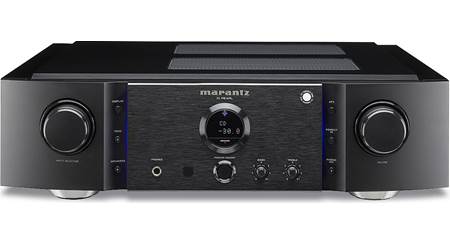
Marantz Reference Series PM-KI Pearl
- 90 watts x 2 channels into 8 ohms (5-40,000 Hz) at 0.05% THD
- audiophile-grade components hand-selected by Ken Ishiwata
- 6 RCA audio inputs (including phono input)
Loading...
Loading accessories...
Customer Q&A
Loading...
Loading articles...


